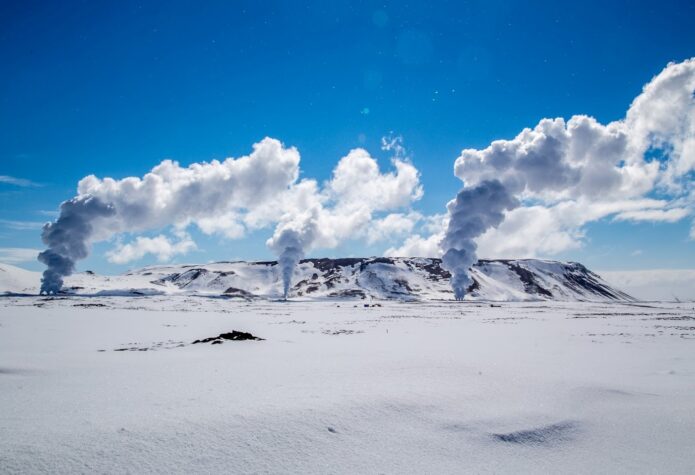Landsvirkjun: Iceland’s energy answer comes naturally

Thanks to its location on a volatile section of the Mid-Atlantic Ridge, where shifting tectonic plates push heat from the Earth’s core to the surface, Iceland has become a pioneer in the use of geothermal energy. A new, NIB-financed power station will contribute an additional 4% to geothermal electricity for households and industry.
Iceland’s unique natural conditions, including abundant hydropower and geothermal resources, have allowed the country to move from importing fossil fuels and coal to generating its own heat and power.
Today, practically all stationary power is derived from indigenous renewable sources. According to Iceland’s national energy authority, geothermal sources make up about 25% of that.
Some 27 kilometres south of the town of Húsavik in Northern Iceland, in an area called Theistareykir, the country’s largest electricity producer Landsvirkjun has now inaugurated a new geothermal power station.
The new plant has a total capacity of 90 MW, and was constructed in two 45 MW phases. The first turbine was installed and set in commercial operation last November, with the second turbine following this April. The plant will mainly cover the electricity demand of local industry and the municipalities of Húsavik and Akureyri.
“The Theistareykir area has great geothermal energy generation potential, with an estimated capacity of up to 200 MW”, explains Mr Valur Knutsson, Senior Project Manager at Theistareykir. “It was our intention to harness this energy by creating an efficient and reliable power station that respects the environment.”
Digging deeper
“Geothermal energy is captured by drilling wells into the ground to reach geothermal fluid at a depth of about 2,000 metres. The fluid is transported to the separating station, where steam is separated from the liquid”, says Mr Knutsson. “The steam is then used for electricity generation, while the liquid is returned to the reservoir.”

Our intention is to harness this energy by creating an efficient and reliable power station that respects the environment.
Valur Knutsson
Senior Project Manager, Landsvirkjun
Considered to be a renewable source of energy, geothermal power requires no fuel, and is therefore immune to fuel cost fluctuations.
“The Theistareykir Power Plant is the first geothermal power plant to be assessed under a new Geothermal Sustainability Assessment Protocol, which has been developed in cooperation with the Icelandic power companies and Iceland’s Environment Agency”, explains Mr Knutsson.
During the construction phase, Landsvirkjun gave special consideration to the unique nature of the Theistareykir area.
“The region was previously almost untouched, so demarcation of protected areas for archaeological and environmental reasons was considered during the planning stage.”
“We will continue to monitor the effect the geothermal utilisation has on the surrounding environment. This includes surface temperature, ground water, air quality, and animal life”, he adds. “Now, at the start of operations, we are also at the final stage of implementing countermeasures regarding grazing land reclamation as well as re-vegetation measures to compensate for land lost due to the construction.”
“In addition to the preservation and landscaping measures, we have launched a contest for artwork near the power station in collaboration with the Icelandic Design Centre”, says Mr Knutsson. “Installing art has the purpose of enriching the experience of visitors to the plant, to involve them and to emphasise the uniqueness of the area.”
Preparing for a low-carbon future
Due to its remote location, Iceland’s only opportunity to export its geothermal energy lies in attracting power-intensive industries to the country. Further, local researchers are now trying to dig even deeper into the earth’s crust to harness more of its heat. As a result, in future, geothermal energy could potentially play a larger role as the world moves from fossil fuels to clean energy.
Nearly 40 countries in geothermal-rich territory in Africa, Latin America and the Pacific could produce most of their power using the energy source, and benefit from the Icelandic experience.
“Iceland’s image has become intertwined with renewable energy, and it is now sharing its experience in other regions of the world”, says Mr Knutsson. “Global investors definitely see potential in expanding the clean energy economy, and it is crucial to advance technology in this area.”

